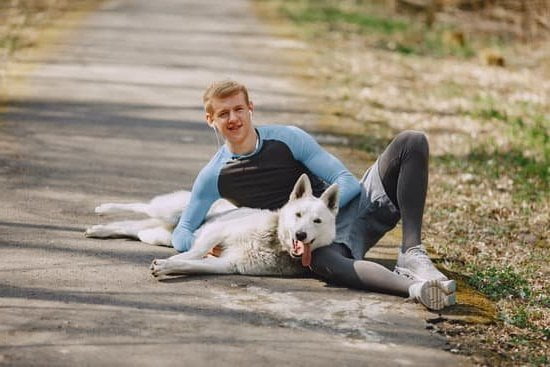How do you train a dog not to hump? Humping behavior in dogs can be both embarrassing and frustrating for pet owners. Understanding why dogs engage in this behavior is crucial in effectively addressing and training them to stop. There are various reasons behind why dogs hump, from sexual arousal to dominance or even just as a form of play. Recognizing the underlying cause is the first step in successfully training your furry friend.
Common reasons for humping behavior include excitement, stress, boredom, or simply seeking attention. It is essential to observe your dog’s body language and the context in which the humping occurs to determine the root cause. Training a dog not to hump is important not only for social etiquette but also for their well-being and safety. Unwanted humping can lead to uncomfortable situations with other pets or humans, and may even result in aggressiveness if not addressed promptly.
Positive reinforcement training techniques are effective in teaching your dog alternative behaviors to replace humping. By rewarding good behavior and ignoring or redirecting unwanted actions, you can encourage your dog to engage in more suitable activities. Consistency is key when implementing these techniques, along with setting clear boundaries and providing regular exercise and mental stimulation for your pet. If needed, seeking professional help from a certified trainer or behaviorist can also greatly benefit in modifying this behavior effectively.
Common Reasons for Humping Behavior
When it comes to understanding why dogs hump, it’s essential to recognize that this behavior can stem from various factors. One common reason for humping behavior in dogs is sexual arousal or a way to seek attention. Dogs, like humans, have natural instincts and behaviors, and humping can be one way for them to release pent-up energy or excitement. Another reason could be due to dominance or establishing hierarchy among other dogs or even humans in their environment.
Additionally, stress, anxiety, or even boredom can contribute to a dog’s tendency to hump. In some cases, medical issues such as urinary tract infections or hormonal imbalances can also lead to increased humping behavior in dogs. Understanding the specific reason behind your dog’s humping habits is crucial in addressing and training them effectively not to engage in this behavior.
To train a dog not to hump successfully, it’s important to consider these underlying reasons when implementing training techniques. By addressing the root cause of the behavior, you can tailor your training approach accordingly and help your dog overcome their humping habits through positive reinforcement and redirection strategies.
| Reasons for Humping Behavior | Training Techniques |
|---|---|
| Sexual arousal or seeking attention | Positive reinforcement with treats and praise |
| Dominance or hierarchy establishment | Redirecting the behavior with commands and distractions |
| Stress, anxiety, or boredom | Consistency in training and setting boundaries |
The Importance of Training a Dog Not to Hump
Understanding the Reasons Behind Humping Behavior
Before diving into the training techniques to discourage humping in dogs, it is crucial to understand why they exhibit this behavior. Humping can be a result of various factors such as excitement, dominance, stress, or even seeking attention. By identifying the underlying reason behind your dog’s humping, you can address the issue more effectively and tailor your training approach accordingly.
The Impact of Allowing Humping Behavior
While some pet owners may find their dog’s humping behavior amusing or harmless, it is essential to recognize the potential negative consequences of allowing this behavior to persist. Allowing a dog to hump can lead to social awkwardness in public settings, discomfort for guests or family members, and even aggression issues if not addressed promptly. By training your dog not to hump, you are promoting better social interactions and a more well-behaved pet overall.
Creating a Positive and Respectful Relationship
Training a dog not to hump goes beyond just correcting unwanted behavior – it is about fostering a positive and respectful relationship between you and your furry companion. Through consistent training using positive reinforcement techniques, you are establishing clear boundaries and communication with your dog. This builds trust and mutual understanding, strengthening the bond between you and ensuring a harmonious coexistence.
Positive Reinforcement Training Techniques
One way to utilize positive reinforcement is by using a cue word or signal when your dog begins to exhibit humping behavior. As soon as you notice them starting to hump, use the cue word or signal and then redirect their attention to a different activity, such as performing tricks or playing fetch.
Once they engage in the desired behavior instead of humping, be sure to reward them immediately with treats and praise. Consistency in using the cue word and providing positive reinforcement will help your dog understand what is expected of them.
In addition to treats and praise, another effective positive reinforcement technique is clicker training. By associating the sound of a clicker with receiving a reward, you can effectively communicate with your dog when they have done something right. Whenever your dog chooses not to hump or follows a command successfully, use the clicker to mark the behavior and then reward them with a treat.
This clear communication between you and your pet reinforces their good behavior and encourages them to continue making positive choices. With patience and consistency in applying positive reinforcement techniques, you can successfully train your dog not to hump.
Redirecting the Behavior With Commands and Distractions
Humping behavior in dogs can be embarrassing and uncomfortable for both pet owners and those around them. It is essential to address this behavior promptly to prevent it from becoming a habit. One effective way to train a dog not to hump is by redirecting the behavior with commands and distractions.
Commands
Training your dog to respond to commands is a fundamental aspect of addressing humping behavior. When you catch your dog in the act or about to hump, use a firm, but calm vocal command such as “No” or “Stop.” Consistency is key here; make sure to use the same command every time your dog exhibits humping behavior. Over time, your dog will associate the command with stopping the unwanted behavior.
Distractions
Another useful technique for redirecting humping behavior is to distract your dog with alternative activities. For example, if you notice your dog starting to hump, try engaging them in play with their favorite toy or going for a walk. By diverting their attention away from the humping behavior, you can help break the habit over time. Remember that positive reinforcement is crucial; praise and reward your dog when they engage in these alternative activities instead of humping.
By incorporating commands and distractions into your training routine, you can effectively redirect your dog’s humping behavior. This approach not only helps address the immediate issue but also strengthens the bond between you and your furry friend by promoting positive interactions. Remember that patience and consistency are essential when training a dog not to hump – with time and effort, you can successfully modify this behavior.
Consistency in Training and Setting Boundaries
Training a dog not to hump requires consistency and setting clear boundaries. Dogs thrive on routine and structure, so it is crucial to maintain a consistent approach to training. By being consistent in your commands and expectations, you can effectively communicate to your dog what behavior is acceptable and what is not.
One way to achieve consistency in training is by establishing a set of rules and boundaries for your dog. This can include teaching them basic obedience commands such as “sit,” “stay,” and “leave it.” By consistently reinforcing these commands, you are helping your dog understand their role in the household hierarchy and reinforcing good behavior.
In addition to setting boundaries through commands, consistency also involves being diligent in correcting unwanted behaviors. For example, if your dog starts humping, immediately redirect their attention by using a command like “off” or “stop.” Consistently enforcing these commands will help your dog learn that humping is not acceptable behavior.
Seeking Professional Help if Needed
Sometimes, despite your best efforts, training your dog not to hump can be challenging. If you find that the humping behavior persists despite consistent training and redirection techniques, seeking professional help may be necessary. A professional dog trainer or behaviorist can provide expert guidance on how to address the underlying issues causing the humping behavior.
When seeking professional help for training your dog not to hump, it’s important to look for someone who has experience working with similar behavioral issues. The trainer or behaviorist will assess your dog’s behavior and develop a customized training plan to address the humping problem effectively. They may also provide additional techniques and strategies to help modify your dog’s behavior.
To find a reputable professional to help with training your dog not to hump, consider asking for recommendations from your veterinarian or other pet owners. You can also research local trainers and behaviorists online or through pet care organizations. By enlisting the help of a qualified professional, you can increase the chances of successfully modifying your dog’s behavior and improving their overall well-being.
- Research local trainers and behaviorists with experience in addressing humping behavior
- Ask for recommendations from your veterinarian or other pet owners
- Enlist the help of a qualified professional to develop a customized training plan
Tips for Preventing Humping in Different Situations
Humping behavior in dogs can be quite embarrassing and uncomfortable for pet owners, especially when it happens in different situations. Whether your dog is humping a guest’s leg, a pillow, or even another pet, it’s essential to address this behavior promptly. So, how do you train a dog not to hump in various situations?
One effective tip for preventing humping in different scenarios is to provide plenty of mental and physical stimulation for your dog. Make sure your furry friend gets enough exercise and playtime to release excess energy that may lead to humping behavior. Engaging your dog in interactive games, training sessions, and daily walks can help redirect their focus and prevent them from engaging in humping.
Another important strategy is to supervise your dog closely in social situations where they may be tempted to hump. If you notice your dog displaying signs of mounting behavior, such as stiffening or raising their front paws, intervene immediately by using a distraction technique or giving them a command like “sit” or “leave it.” Consistency is key in reinforcing the message that humping is not acceptable behavior.
Additionally, consider spaying or neutering your dog if they have not already been altered. This can help reduce hormone-driven behaviors like humping and decrease the likelihood of unwanted sexual behaviors.
If despite these efforts, your dog continues to exhibit persistent humping behavior that is causing distress, it may be beneficial to seek the assistance of a professional dog trainer or animal behaviorist for further guidance on modifying this behavior. By implementing these tips and being proactive in preventing humping in different situations, you can successfully train your dog not to engage in this unwanted behavior.
Conclusion
Successfully training your dog not to hump requires a combination of understanding the reasons behind this behavior, implementing positive reinforcement techniques, and consistently setting boundaries. It is important to recognize that humping can be a natural behavior in dogs, but it can also be triggered by various factors such as anxiety, excitement, or even boredom. By identifying the root cause of the behavior, you can address it more effectively.
Positive reinforcement training techniques, such as rewarding good behavior with treats or praise, can help steer your dog away from humping. Redirecting the behavior with commands like “sit” or “down” can also be useful in teaching your dog alternative behaviors. Consistency is key when training your dog not to hump – having clear boundaries and following through with consequences for unwanted behavior will reinforce the message that humping is not acceptable.
If despite your efforts, your dog continues to exhibit humping behavior persistently or aggressively, seeking professional help from a certified dog trainer or animal behaviorist may be necessary. They can provide specialized guidance and strategies tailored to your specific situation.
Remember that every dog is unique, and what works for one may not work for another. By staying patient and committed to the training process, you can successfully train your dog not to hump and build a stronger bond with your furry companion.
Frequently Asked Questions
Can Dogs Be Taught Not to Hump?
Dogs can be taught not to hump through consistent training and positive reinforcement. It’s important to redirect their behavior, provide plenty of exercise, and seek help from a professional trainer if needed.
How Do I Make Sure My Dog Doesn’t Hump?
To ensure your dog doesn’t hump, it’s essential to provide them with enough physical and mental stimulation. This includes regular exercise, interactive toys, and obedience training. Additionally, neutering or spaying your dog can help reduce humping behavior.
Should You Let Dogs Hump Dominance?
Allowing dogs to hump for dominance can reinforce unwanted behavior and lead to issues with aggression or resource guarding. It’s crucial to address this behavior through training and redirection rather than allowing it as a means of establishing dominance in the pack.

Welcome to the blog! I am a professional dog trainer and have been working with dogs for many years. In this blog, I will be discussing various topics related to dog training, including tips, tricks, and advice. I hope you find this information helpful and informative. Thanks for reading!





